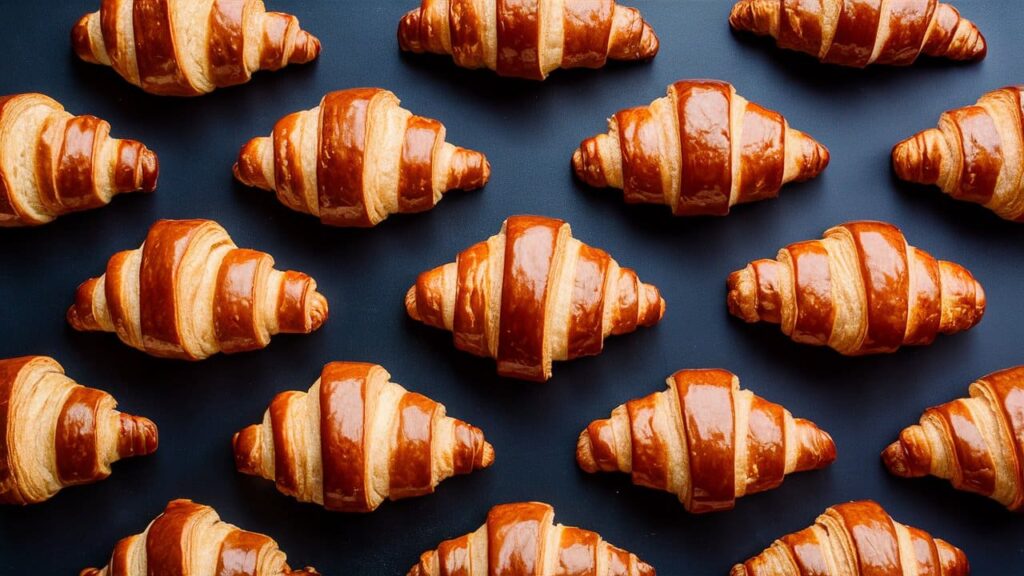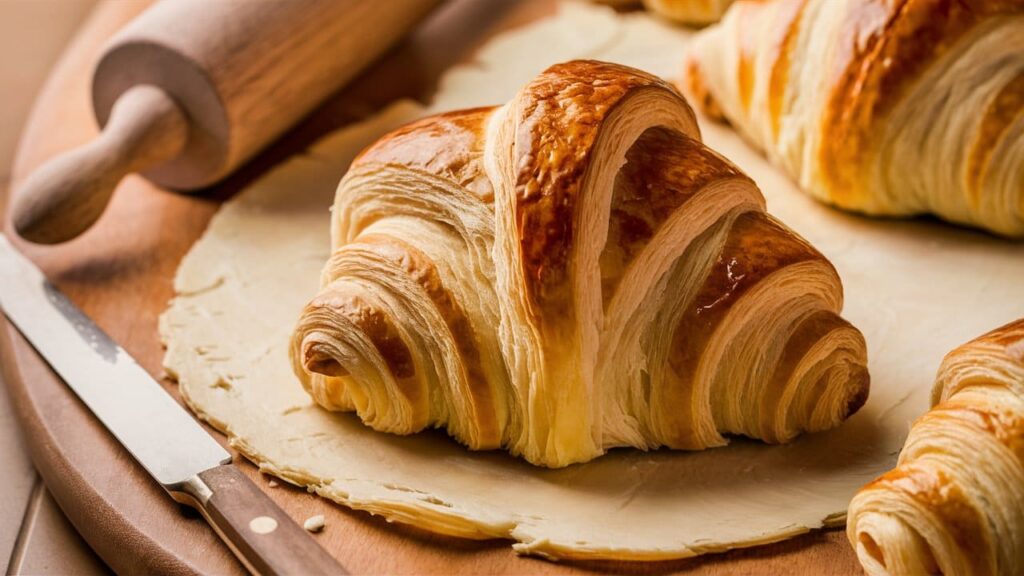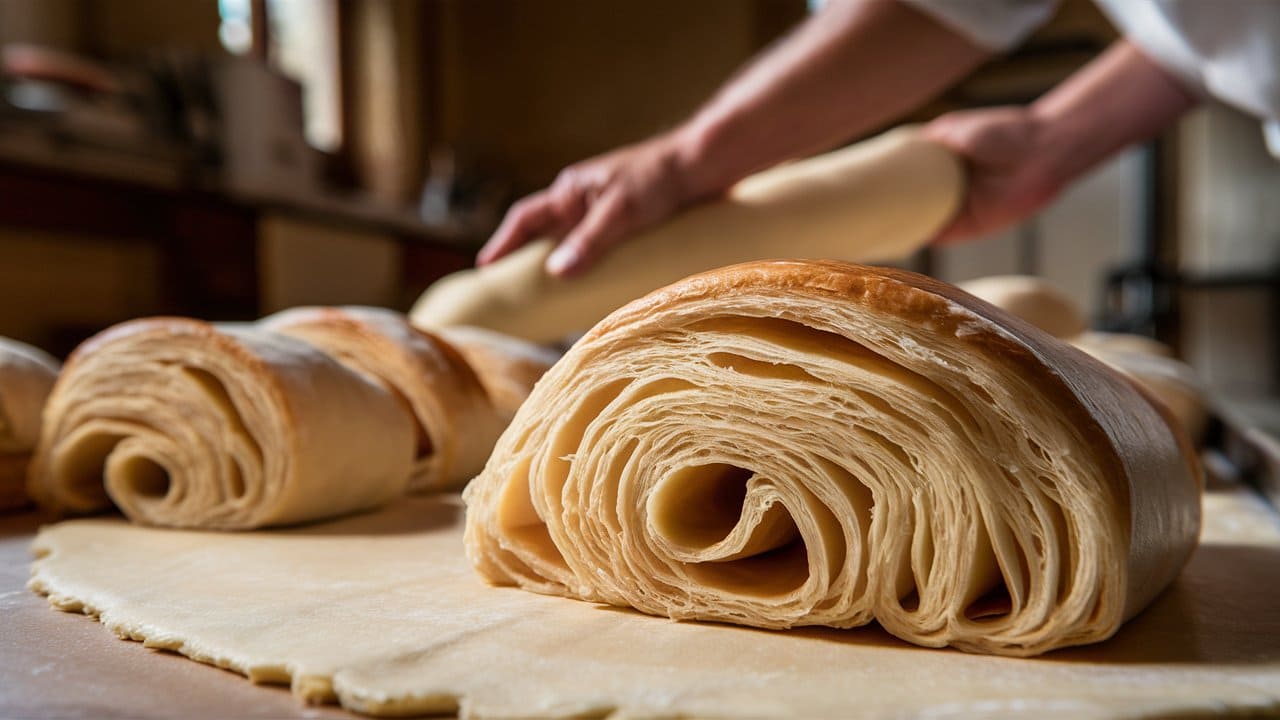Croissants and puff pastry are both beloved for their flaky, buttery layers, but is croissant dough the same as puff pastry? While they share some similarities, they are distinct in their ingredients, preparation methods, and uses. This article delves into the differences and similarities between croissant dough and puff pastry, providing a comprehensive understanding of each.
Understanding Croissant Dough
Ingredients in Croissant Dough
Croissant dough is a type of laminated dough, meaning it is composed of layers of dough and butter. The primary ingredients include:
- Flour: Typically all-purpose flour, which provides structure.
- Yeast: Active dry or instant yeast is used to help the dough rise and become light and airy.
- Milk: Often used instead of water to create a richer dough.
- Butter: Incorporated in layers to create the signature flakiness.
- Sugar and Salt: Added for flavor.
Preparation Method
The preparation of croissant dough involves several steps:
- Mixing: Ingredients are mixed to form a dough, which is then allowed to rise.
- Laminating: The dough is rolled out and layered with butter through a process called laminating, which involves folding the dough over the butter multiple times.
- Shaping: The dough is cut into triangles and rolled into croissant shapes.
- Proofing and Baking: The croissants are allowed to rise before being baked until golden brown and flaky.
Texture and Flavor
Croissant dough results in a pastry that is flaky on the outside, soft and slightly chewy on the inside, with a rich, buttery flavor. The yeast in the dough gives it a light, airy texture, while the sugar adds a subtle sweetness.
Understanding Puff Pastry
Ingredients in Puff Pastry
Puff pastry is another type of laminated dough but with some key differences in its ingredients:
- Flour: Again, all-purpose flour is commonly used.
- Butter: A large amount of butter is used to create layers.
- Water: Cold water is used to bring the dough together.
- Salt: Added for flavor.
Preparation Method
The preparation of puff pastry is intricate and precise:
- Mixing: The flour, water, and salt are mixed to form a dough.
- Laminating: Much like croissant dough, puff pastry dough is rolled out and layered with butter. This process, known as “turns” or “folds,” is repeated multiple times to create many thin layers.
- Chilling: The dough is often chilled between folds to keep the butter from melting.
- Baking: Puff pastry is baked until it puffs up and turns golden brown, creating numerous flaky layers.
Texture and Flavor
Puff pastry is known for its crisp, flaky texture. Unlike croissant dough, it does not contain yeast, so it relies entirely on the steam generated from the butter and water to puff up. The result is a lighter, crisper texture compared to croissant dough.
Key Differences Between Croissant Dough and Puff Pastry
Yeast vs. No Yeast
One of the main differences between croissant dough and puff pastry is the presence of yeast. Croissant dough includes yeast, which contributes to its airy, soft texture. Puff pastry, on the other hand, relies solely on steam for its rise, resulting in a crisper, more delicate texture.
Sugar Content
Croissant dough typically contains a small amount of sugar, which adds a slight sweetness and helps with browning during baking. Puff pastry, however, usually does not contain sugar, making it more neutral in flavor and suitable for both sweet and savory applications.
Texture and Rise
The texture of croissant dough is tender and slightly chewy, thanks to the yeast and the multiple layers of butter. Puff pastry, without yeast, is all about the crisp, flaky layers created by the steam from the butter. The rise in croissant dough is due to the yeast and the lamination process, while puff pastry relies entirely on the steam for its lift.
Culinary Uses for Croissant Dough
Classic Croissants
The most well-known use for croissant dough is, of course, croissants. These buttery, flaky pastries are enjoyed plain, filled with chocolate (pain au chocolat), or even as savory options with ham and cheese.
Croissant Variations
Croissant dough can also be used to make a variety of pastries:
- Danishes: Often filled with fruit, cream cheese, or custard.
- Pain au Raisin: A spiral pastry filled with raisins and often flavored with custard or frangipane.
Savory Applications
Croissant dough isn’t limited to sweet treats. It can be used to make savory items such as:
- Savory Croissants: Filled with ingredients like ham, cheese, and herbs.
- Croissant Sandwiches: Using croissants as a base for sandwiches, filled with meats, cheeses, and vegetables.

Culinary Uses for Puff Pastry
Pastry Shells
Puff pastry is often used to make pastry shells for both sweet and savory dishes:
- Vol-au-vents: Small hollow cases filled with savory fillings like chicken or seafood.
- Tarts: Both sweet and savory tarts, filled with fruits, custards, or vegetables.
Puff Pastry Desserts
- Napoleons: Layered desserts with puff pastry, pastry cream, and icing.
- Apple Turnovers: Puff pastry filled with spiced apples and baked until golden.
Savory Puff Pastry Dishes
Puff pastry is also popular in savory dishes:
- Beef Wellington: A filet of beef coated with pâté and duxelles, then wrapped in puff pastry and baked.
- Pigs in a Blanket: Sausages wrapped in puff pastry and baked until golden.
Detailed Recipes and Techniques for Working with Croissant Dough and Puff Pastry
In this section, we will delve into detailed recipes and techniques for making and using croissant dough and puff pastry. Understanding the intricacies of these recipes can help you master the art of creating delicious, flaky pastries.
Making Croissant Dough from Scratch
Ingredients and Equipment
To make croissant dough, you will need the following ingredients:
- 4 cups (500g) all-purpose flour
- 1/4 cup (50g) granulated sugar
- 2 1/4 teaspoons (7g) active dry yeast
- 1 1/2 teaspoons (9g) salt
- 1 1/4 cups (300ml) whole milk, warmed
- 1 cup (225g) unsalted butter, cold and cut into pieces
You will also need:
- A stand mixer with a dough hook
- Rolling pin
- Parchment paper
- Plastic wrap
Step-by-Step Instructions
- Prepare the Dough: In a stand mixer bowl, combine the flour, sugar, yeast, and salt. Add the warm milk and mix on low speed until the dough comes together. Increase the speed to medium and knead for about 5 minutes until smooth.
- Rest and Chill: Shape the dough into a rectangle, wrap it in plastic wrap, and refrigerate for at least 30 minutes.
- Laminating with Butter: Roll out the cold butter between two sheets of parchment paper into a 7×7 inch square. Roll the chilled dough into a 10×10 inch square. Place the butter in the center of the dough and fold the corners of the dough over the butter, sealing it completely.
- Rolling and Folding: Roll the dough into a 20×10 inch rectangle. Fold the dough into thirds like a letter. Wrap him and refrigerate for 30 minutes Repeat this rolling and folding process two more times, chilling between each turn.
- Final Roll and Shape: After the final chill, roll the dough into a 20×10 inch rectangle. Cut the dough into triangles for croissants. Roll each triangle from the base to the tip to form the croissant shape.
- Proof and Bake: Place the croissants on a baking sheet, cover, and let them rise at room temperature for 1-2 hours until puffy. Preheat the oven to 375°F (190°C). Brush the croissants with egg wash and bake for 20-25 minutes until golden brown.
Tips for Perfect Croissants
- Temperature Control: Keep the dough and butter cold to ensure proper layering.
- Resting: Allow adequate resting time to develop flavors and structure.
- Proofing: Ensure the croissants are well-proofed before baking for a light, airy texture.
Making Puff Pastry from Scratch
Ingredients and Equipment
To make puff pastry, you will need the following ingredients:
- 2 1/2 cups (315g) all-purpose flour
- 1 cup (225g) unsalted butter, cold and cut into pieces
- 1/2 teaspoon (3g) salt
- 2/3 cup (160ml) cold water
You will also need:
- A stand mixer with a paddle attachment
- Rolling pin
- Parchment paper
- Plastic wrap
Step-by-Step Instructions
- Prepare the Dough: In a stand mixer bowl, combine the flour and salt. Add the cold butter pieces and mix on low speed until the mixture resembles coarse crumbs. Gradually add the cold water and mix until the dough just comes together.
- Rest and Chill: Shape the dough into a rectangle, wrap it in plastic wrap, and refrigerate for at least 30 minutes.
- Laminating: Roll the dough into a 15×10 inch rectangle. Fold the dough into thirds like a letter. Wrap him and refrigerate for 30 min. Repeat this rolling and folding process five more times, chilling between each turn.
- Final Roll and Cut: Cut into the shapes needed for your pastry.
- Bake: Preheat the oven to 400°F (200°C). Bake the puff pastry according to your recipe until golden brown and flaky.
Tips for Perfect Puff Pastry
- Keep Everything Cold: Ensure the dough and butter remain cold throughout the process to achieve the flaky layers.
- Use a Sharp Knife: When cutting puff pastry, use a sharp knife to prevent compressing the layers.
- Bake at High Temperature: The initial high temperature helps the pastry rise and create those distinct flaky layers.

Recipes Using Croissant Dough
Classic Croissants
- Ingredients: Prepared croissant dough, egg wash (1 egg beaten with 1 tablespoon of water)
- Instructions: Follow the croissant dough preparation steps. Shape the dough into croissants, proof, and bake as detailed above.
- Serving: Serve warm, optionally with butter, jam, or chocolate spread.
Chocolate Croissants (Pain au Chocolat)
- Ingredients: Prepared croissant dough, chocolate batons or dark chocolate pieces, egg wash
- Instructions: Roll out the croissant dough and cut into rectangles. Place a chocolate baton on one end and roll up the dough. Proof and bake as directed for classic croissants.
- Serving: Enjoy warm with a dusting of powdered sugar.
Ham and Cheese Croissants
- Ingredients: Prepared croissant dough, sliced ham, shredded cheese (Gruyère or Cheddar), egg wash
- Instructions: Roll out the dough and cut into triangles. Place a slice of ham and a sprinkle of cheese on the wide end of each triangle and roll up. Proof and bake as directed.
- Serving: Serve warm for a savory breakfast or snack.
Recipes Using Puff Pastry
Vol-au-Vents
- Ingredients: Prepared puff pastry, egg wash
- Instructions: Roll out the puff pastry and cut into circles. Cut a smaller circle out of half of the circles to create rings. Stack the rings on top of the full circles, brush with egg wash, and bake until golden.
- Serving: Fill with savory fillings like chicken and mushrooms or sweet fillings like pastry cream and fruit.
Napoleons
- Ingredients: Prepared puff pastry, pastry cream, powdered sugar
- Instructions: Roll out the puff pastry and cut into rectangles. Bake until golden and crisp. Layer with pastry cream between the pastry rectangles and dust with powdered sugar.
- Serving: Serve chilled as a classic French dessert.
Sausage Rolls
- Ingredients: Prepared puff pastry, sausage meat, egg wash
- Instructions: Roll out the puff pastry and cut into strips. Place sausage meat along each strip, roll up, and seal the edges. Cut into pieces, brush with egg wash, and bake until golden.
- Serving: Serve warm as a savory appetizer or snack.
Conclusion
Croissant dough and puff pastry, while similar in their buttery, flaky nature, are distinct in their ingredients, preparation methods, and culinary applications. Croissant dough, enriched with yeast, produces a tender, airy pastry perfect for breakfast items and sandwiches. Puff pastry, relying solely on steam for its rise, offers a crisp, flaky texture ideal for both sweet and savory dishes. By understanding and mastering the techniques for making and using these doughs, you can expand your baking repertoire and create a variety of delicious pastries. Whether you’re crafting classic croissants or elegant vol-au-vents, these recipes and tips will help you achieve professional-quality results in your own kitchen.
You can get more recipes from here:

